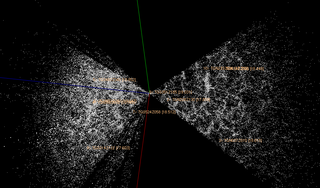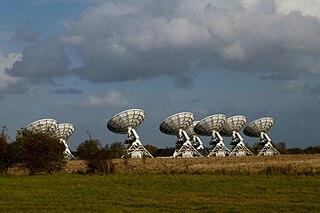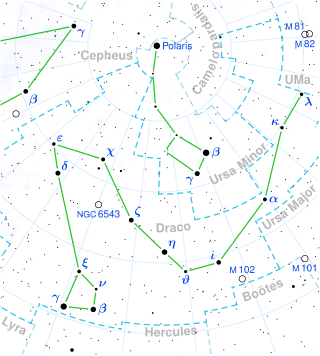Related Research Articles

In physical cosmology, the Copernican principle states that humans, on the Earth or in the Solar System, are not privileged observers of the universe, that observations from the Earth are representative of observations from the average position in the universe. Named for Copernican heliocentrism, it is a working assumption that arises from a modified cosmological extension of Copernicus' argument of a moving Earth.
The study of galaxy formation and evolution is concerned with the processes that formed a heterogeneous universe from a homogeneous beginning, the formation of the first galaxies, the way galaxies change over time, and the processes that have generated the variety of structures observed in nearby galaxies. Galaxy formation is hypothesized to occur from structure formation theories, as a result of tiny quantum fluctuations in the aftermath of the Big Bang. The simplest model in general agreement with observed phenomena is the Lambda-CDM model—that is, that clustering and merging allows galaxies to accumulate mass, determining both their shape and structure. Hydrodynamics simulation, which simulates both baryons and dark matter, is widely used to study galaxy formation and evolution.
In modern physical cosmology, the cosmological principle is the notion that the spatial distribution of matter in the universe is uniformly isotropic when viewed on a large enough scale, since the forces are expected to act equally throughout the universe on a large scale, and should, therefore, produce no observable inequalities in the large-scale structuring over the course of evolution of the matter field that was initially laid down by the Big Bang.

The Giant Metrewave Radio Telescope (GMRT), located near Narayangaon, Pune in India, is an array of thirty fully steerable parabolic radio telescopes of 45 metre diameter, observing at metre wavelengths. It is the largest and most sensitive radio telescope array in the world at low frequencies. It is operated by the National Centre for Radio Astrophysics (NCRA), a part of the Tata Institute of Fundamental Research, Mumbai. It was conceived and built under the direction of Govind Swarup during 1984 to 1996. It is an interferometric array with baselines of up to 25 kilometres (16 mi). It was recently upgraded with new receivers, after which it is also known as the upgraded Giant Metrewave Radio Telescope (uGMRT).
The Lambda-CDM, Lambda cold dark matter or ΛCDM model is a mathematical model of the Big Bang theory with three major components:
- a cosmological constant denoted by lambda (Λ) associated with dark energy,
- the postulated cold dark matter, and
- ordinary matter.

In astronomy, a redshift survey is a survey of a section of the sky to measure the redshift of astronomical objects: usually galaxies, but sometimes other objects such as galaxy clusters or quasars. Using Hubble's law, the redshift can be used to estimate the distance of an object from Earth. By combining redshift with angular position data, a redshift survey maps the 3D distribution of matter within a field of the sky. These observations are used to measure detailed statistical properties of the large-scale structure of the universe. In conjunction with observations of early structure in the cosmic microwave background, these results can place strong constraints on cosmological parameters such as the average matter density and the Hubble constant.

The Arcminute Microkelvin Imager (AMI) consists of a pair of interferometric radio telescopes - the Small and Large Arrays - located at the Mullard Radio Astronomy Observatory near Cambridge. AMI was designed, built and is operated by the Cavendish Astrophysics Group. AMI was designed, primarily, for the study of galaxy clusters by observing secondary anisotropies in the cosmic microwave background (CMB) arising from the Sunyaev–Zel'dovich (SZ) effect. Both arrays are used to observe radiation with frequencies between 12 and 18 GHz, and have very similar system designs. The telescopes are used to observe both previously known galaxy clusters, in an attempt to determine, for example, their masses and temperatures, and to carry out surveys, in order to locate previously undiscovered clusters.
The Millennium Run, or Millennium Simulation is a computer N-body simulation used to investigate how the distribution of matter in the Universe has evolved over time, in particular, how the observed population of galaxies was formed. It is used by scientists working in physical cosmology to compare observations with theoretical predictions.

The Sloan Great Wall (SGW) is a cosmic structure formed by a giant wall of galaxies. Its discovery was announced from Princeton University on October 20, 2003, by J. Richard Gott III, Mario Jurić, and their colleagues, based on data from the Sloan Digital Sky Survey.

In cosmology, galaxy filaments are the largest known structures in the universe, consisting of walls of galactic superclusters. These massive, thread-like formations can commonly reach 50/h to 80/h Megaparsecs — with the largest found to date being the Hercules-Corona Borealis Great Wall at around 3 gigaparsecs (9.8 Gly) in length — and form the boundaries between voids. Due to the accelerating expansion of the universe, the individual clusters of gravitationally bound galaxies that make up galaxy filaments are moving away from each other at an accelerated rate; in the far future they will dissolve.

In cosmology, the steady-state model or steady state theory is an alternative to the Big Bang theory. In the steady-state model, the density of matter in the expanding universe remains unchanged due to a continuous creation of matter, thus adhering to the perfect cosmological principle, a principle that says that the observable universe is always the same at any time and any place.

45 Draconis is a single star located in the northern circumpolar constellation of Draco, around 3,500 light years from the Earth. 45 Draconis is the Flamsteed designation, while it has the Bayer designation of d Draconis. This object is visible to the naked eye as a faint, yellow-white hued star with an apparent visual magnitude of 4.78. Radial velocity measurements indicate it is moving closer to the Sun at the rate of −12.5 km/s.
The XMM Cluster Survey (XCS) is a serendipitous X-ray galaxy cluster survey being conducted using archival data taken by ESA’s XMM-Newton satellite. Galaxy clusters trace the large scale structure of the universe, and their number density evolution with redshift provides a way to measure cosmological parameters, independent of cosmic microwave background experiments or supernovae cosmology projects.
A large quasar group (LQG) is a collection of quasars that form what are thought to constitute the largest astronomical structures in the observable universe. LQGs are thought to be precursors to the sheets, walls and filaments of galaxies found in the relatively nearby universe.

9 Pegasi is a supergiant star in the constellation Pegasus. Its apparent magnitude is 4.35.

The Huge Large Quasar Group, is a possible structure or pseudo-structure of 73 quasars, referred to as a large quasar group, that measures about 4 billion light-years across. At its discovery, it was identified as the largest and the most massive known structure in the observable universe, though it has been superseded by the Hercules–Corona Borealis Great Wall at 10 billion light-years. There are also issues about its structure.
The Clowes–Campusano LQG is a large quasar group, consisting of 34 quasars and measuring about 2 billion light-years across. It is one of the largest known superstructures in the observable universe. It is located near the larger Huge-LQG. It was discovered by the astronomers Roger Clowes and Luis Campusano in 1991.

Cosmic voids are vast spaces between filaments, which contain very few or no galaxies. Most galaxies are not located in voids, despite their size, due to most galaxies being gravitationally bound together, creating huge cosmic structures known as galaxy filaments. The cosmological evolution of the void regions differs drastically from the evolution of the Universe as a whole: there is a long stage when the curvature term dominates, which prevents the formation of galaxy clusters and massive galaxies. Hence, although even the emptiest regions of voids contain more than ~15% of the average matter density of the Universe, the voids look almost empty to an observer.
The KBC Void is an immense, comparatively empty region of space, named after astronomers Ryan Keenan, Amy Barger, and Lennox Cowie, who studied it in 2013. The existence of a local underdensity has been the subject of many pieces of literature and research articles.
References
- 1 2 3 4 5 6 Clowes, Roger; Luis E. Campusano; Matthew J. Graham & Ilona K. S¨ochting (2012). "Two close Large Quasar Groups of size ∼ 350 Mpc at z ∼ 1.2". Monthly Notices of the Royal Astronomical Society. 419 (1): 556. arXiv: 1108.6221 . Bibcode:2012MNRAS.419..556C. doi:10.1111/j.1365-2966.2011.19719.x. S2CID 31553670.
- ↑ Yadav, Jaswant; J. S. Bagla & Nishikanta Khandai (25 February 2010). "Fractal dimension as a measure of the scale of homogeneity". Monthly Notices of the Royal Astronomical Society . 405 (3): 2009–2015. arXiv: 1001.0617 . Bibcode:2010MNRAS.405.2009Y. doi:10.1111/j.1365-2966.2010.16612.x. S2CID 118603499.
- ↑ Hogg, David W.; Eisenstein, Daniel J.; Blanton, Michael R.; Bahcall, Neta A.; Brinkmann, J.; Gunn, James E.; Schneider, Donald P. (2005). "Cosmic Homogeneity Demonstrated with Luminous Red Galaxies". The Astrophysical Journal. 624 (1): 54–58. arXiv: astro-ph/0411197 . Bibcode:2005ApJ...624...54H. doi:10.1086/429084. S2CID 15957886.
- ↑ Scrimgeour, Morag I.; et al. (2012). "The WiggleZ Dark Energy Survey: The transition to large-scale cosmic homogeneity". Monthly Notices of the Royal Astronomical Society. 425 (1): 116–134. arXiv: 1205.6812 . Bibcode:2012MNRAS.425..116S. doi:10.1111/j.1365-2966.2012.21402.x. S2CID 19959072.
- ↑ Nadathur, S. (2013). "Seeing patterns in noise: Gigaparsec-scale 'structures' that do not violate homogeneity". Monthly Notices of the Royal Astronomical Society. 434 (1): 398–406. arXiv: 1306.1700 . Bibcode:2013MNRAS.434..398N. doi:10.1093/mnras/stt1028.


